
* A Distributed Proofreaders Canada eBook *
This eBook is made available at no cost and with very few restrictions. These restrictions apply only if (1) you make a change in the eBook (other than alteration for different display devices), or (2) you are making commercial use of the eBook. If either of these conditions applies, please check with an FP administrator before proceeding.
This work is in the Canadian public domain, but may be under copyright in some countries. If you live outside Canada, check your country's copyright laws. If the book is under copyright in your country, do not download or redistribute this file.
Title: The National Parks in Ontario: A story of islands and shorelines
Date of first publication: 1963
Author: David M. Baird
Date first posted: Aug. 24, 2014
Date last updated: Aug. 24, 2014
Faded Page eBook #20140874
This eBook was produced by: Stephen Hutcheson, Chris Curnow & the online Distributed Proofreaders Canada team at http://www.pgdpcanada.net

• St. Lawrence Islands
• Georgian Bay Islands and Flowerpot Island
• Point Pelee
David M. Baird
MISCELLANEOUS REPORT 7
Issued by
THE GEOLOGICAL SURVEY OF CANADA
Department of Mines and Technical Surveys, Ottawa
50 cents
Roger Duhamel, f.r.s.c.
Queen’s Printer and Controller of Stationery
Ottawa, Canada
1963
© Crown Copyrights reserved
Available by mail from the Queen’s Printer, Ottawa,
and at the following Canadian Government bookshops:
OTTAWA
Daly Building, Corner Mackenzie and Rideau
TORONTO
Mackenzie Building, 36 Adelaide St. East
MONTREAL
Aeterna-Vie Building, 1182 St. Catherine St. West
or through your bookseller
A deposit copy of this publication is also available for reference in public libraries across Canada
Price 50 cents Catalogue No. M 41-8/7
Prices subject to change without notice
All photos are by the author. Maps are by the Cartography Unit, Geological Surrey of Canada, Ottawa.
The two flowerpots on Flowerpot Island show clearly that they have been eroded out of the cliffs by the action of the waves and isolated here on the shore. You can see that the upper part of the nearer one is made of massive limestone corresponding to the cliff behind it. The thin-bedded lower part has been reinforced with masonry to protect it from further erosion, otherwise it would eventually topple over.
Three of Canada’s National Parks are in the Province of Ontario:
St. Lawrence Islands National Park in the St. Lawrence River not far from its outlet from Lake Ontario;
Georgian Bay Islands National Park near the southeast corner of Georgian Bay, including Flowerpot Island off the tip of the Bruce Peninsula;
and Point Pelee National Park on Lake Erie.
These park areas are places to enjoy the varied scenery of the Great Lakes and the upper St. Lawrence River. The geology and scenery of each one is described separately in this guidebook, although many features of scenery and history are common to all.
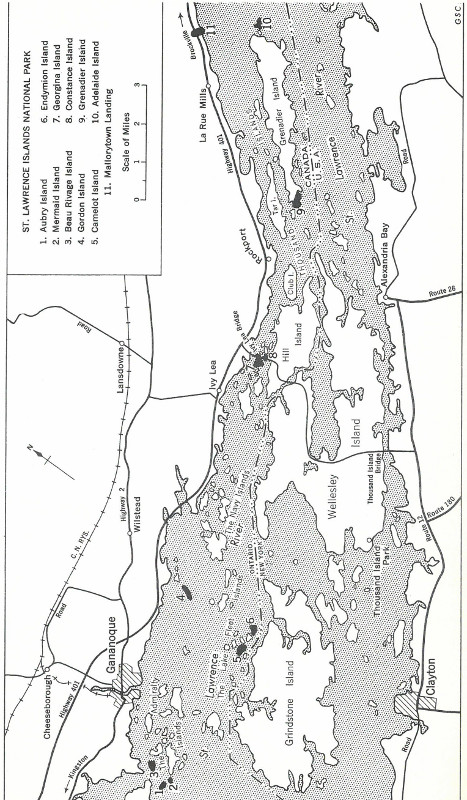
ST. LAWRENCE ISLANDS NATIONAL PARK
Situated in the St. Lawrence River between Kingston and Brockville, St. Lawrence Islands National Park consists of a scattering of islands among the many hundreds in this section of the river. The location and names of these islands are shown on the map.
A very large area of central and eastern Canada is directly underlain by ancient rocks, commonly granite and granite-gneiss, with patches here and there of much-altered sedimentary and volcanic rocks. These are all of ‘Precambrian’ age—that is they are between 600 million and 3 billion years old and predate almost all life on the face of the earth. After a complicated history this great mass of ancient rocks was eroded in Precambrian times to a more or less flat, even surface.
At a period much later in geological time, now about 500 million years ago, the oceans overlapped onto this ancient surface, and sand, mud, and limy mud were deposited in large quantities. These ‘sedimentary’ materials eventually hardened into solid rock so that we now find sandstone, conglomerate, shale, and limestone lying on top of the ancient Precambrian surface. The processes of erosion have gradually stripped back this overlying cover to expose more and more of the old rocks.
The boundary of the overlying rocks and the more ancient underlying rocks extends from the southeast corner of Georgian Bay in an irregular line through Marmora to Kingston and beyond into the United States. It is found again along the Ottawa River from Montreal to Arnprior and thence more or less southward and southeastward to near Brockville. From between Kingston and Brockville the old Precambrian rocks extend southeastward into New York State and include the Adirondack Mountains area. St. Lawrence Islands National Park lies in this belt of Precambrian rocks that crosses the St. Lawrence River. Road-cuts at the Kingston and Brockville ends of this Precambrian ‘bridge’ show, in several places, the transition from the old rocks to the overlying younger rocks. You can see the massive Precambrian rocks, which are commonly pink or dark reddish grey. The younger rocks contrast sharply with the older ones in that they are very clearly layered in nearly horizontal or horizontal beds that make flat, terraced road-cuts on both the Brockville and Kingston ends of this section of the main highway. In the ‘Precambrian bridge area’, you might expect that small patches of the younger rocks would still be found here and there among the older rocks where the stripping has not yet been complete. Gordon Island, about 3 miles east of Gananoque, is made up of sedimentary rocks in just this way.
Long after the rocks had been solidified and eroded in a succession of chapters in the earth’s history, the coming of the great icecap that covered most of northern North America in recent geological time profoundly affected the old landscape of this area. After the glaciers left, a flooding of the land produced the numerous islands which we see now. Let us examine the geological history of the Thousand Islands area chapter by chapter.
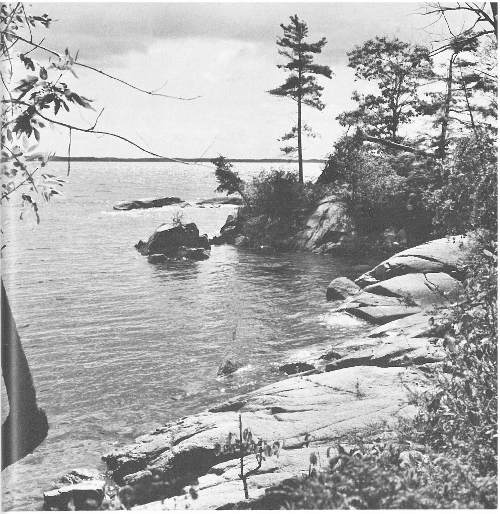
Trees and sparkling water, clouds and rocks—these are the ingredients of the beauty of St. Lawrence Islands National Park. All but the clouds are the way they are because of the recent glacial history of the region. Here on Mermaid Island, rounded masses of granitic rocks tell of the passing ice.
By far the most common rocks in the Thousand Islands are pink granite and granite-gneiss. These consist of three essential minerals: glassy quartz, pink feldspar, which breaks in flat surfaces, and black minerals that may be biotite mica or hornblende. These rocks are usually quite pink on freshly broken surfaces but gradually weather to grey with pink overtones. The granite was probably in a molten or sub-molten stage at one time in its history and solidified on cooling. In some outcrops it is quite obviously banded due to the collection of dark minerals in irregular layers, and for this rock the term ‘granite-gneiss’ is more appropriate. The rock is everywhere massive but is commonly jointed so that it breaks off in large blocks.
The proportion of the three essential minerals varies somewhat, as does the composition of the feldspar in the rock. Thus the appearance changes slightly from place to place. Many of the fireplaces on the islands in the park are built from the dark reddish grey granite that crops out on Beau Rivage Island in the Gananoque section.
Veins and thin tabular sheets (called ‘dykes’) of a fine-grained pink rock are common in all masses of granite. These seem to represent a last stage in the molten history of the igneous rock when a small quantity of liquid rock was [7] squeezed up along cracks and fissures in the rest of the rock, which had already solidified. These little dykes and veins are quite common in the granites of St. Lawrence Islands National Park.
Here and there, small patches of quartzite, formed from much-altered and recrystallized sandstone, are found among the granite islands. You can recognize them by their general homogeneity and the absence of large quantities of pink feldspar with its flat cleavage faces on broken surfaces. These granular aggregates, which started long ago as sands, form large patches in the old Precambrian rocks in the country to the northeast of the Thousand Islands Bridge area and northwest of Mallorytown Landing. A small patch occurs in the park on Georgina Island below the bridge.
Darker gneisses can be found in a few places in the Thousand Islands. These belong to the same general group of rocks as the quartzite and originally they were probably impure sandstones and muds which have been very much altered by pressure and heat—a process geologists call ‘metamorphism’.
Gordon Island is unique among the islands in that it is made entirely of sedimentary rocks belonging to the cover of younger rocks lying on top of the old Precambrian surface. The best exposures are at the dock area where conglomerate and sandstone dip gently away from the viewer. In these rocks you can find pebbles of quartz that rolled around on the bottom of an ancient sea some 500 to 600 million years ago. Now and then some of them wear out of the rock and once again roll around on the beach, pushed to and fro by the force of the waves. We know from the way the sandstone and conglomerate occur on the mainland that these rocks on Gordon Island form but a thin cover over the older granite and granite-gneiss. The well drilled for water just above the dock area on Gordon Island penetrated the older rocks at quite a shallow depth.

Gordon Island is unique among the islands of St. Lawrence Islands National Park in that it is the only one underlain by sedimentary rocks. Here, in the vicinity of the dock, sandstone and conglomerate dip gently away and to the left. All other islands in the park are made of older gneisses and granite.
The present St. Lawrence River and the whole Great Lakes system seem to be features of eastern North America’s very recent geological history. It seems probable that some sort of a river system was developed in what is now Lake Ontario and the upper St. Lawrence River valley in the period of time prior to the coming of the glaciers about a million years ago. And it is certainly unlikely that it had any resemblance at all to what we now find there.
The most important single event in the history of the scenery of the Thousand Islands area began about a million years ago. At that time the climate of the northern part of the world began to get cooler gradually. As it did the snow came a little earlier each winter and stayed on the ground longer and longer each spring. As the climate continued to get colder the snow began to stay on the ground all year round, first in sheltered spots such as steep valleys and on the northern slopes of hills, and finally everywhere. Eventually the whole country was covered by a great blanket of permanent snow.
Over the centuries this cover of snow continued to thicken, increasing the weight of the upper layers until the lower layers became changed to solid ice by a process of recrystallization. And as this tremendous blanket of snow and ice got even thicker, the weight of ice on top squeezed the bottom layers so that they began to flow outward from the higher parts of the country and the places where accumulation was greatest. This process produced an icecap exactly like the ones we can observe today in Greenland or near the South Pole.
For many thousands of years the northern part of North America lay beneath this vast icecap. In time, the cycle of climatic changes that brought the cold in the first place also brought a warming of the climate. In succeeding centuries the icecap began to lose more and more of its volume by melting than it gained from fresh falls of snow. The face of the land was gradually uncovered as the mighty icecap wasted away and disappeared, leaving only a few remnants in the Arctic islands and the high western mountains to remind us of it.
Much evidence points to at least three recurrences of this glacial story, so that the southern part of Canada, at least, was covered by a moving icecap on four successive occasions with long periods of exposure between them. About 10,000 years ago the last of the ice left the region of what is now the Thousand Islands. But the face of the land had been entirely changed.
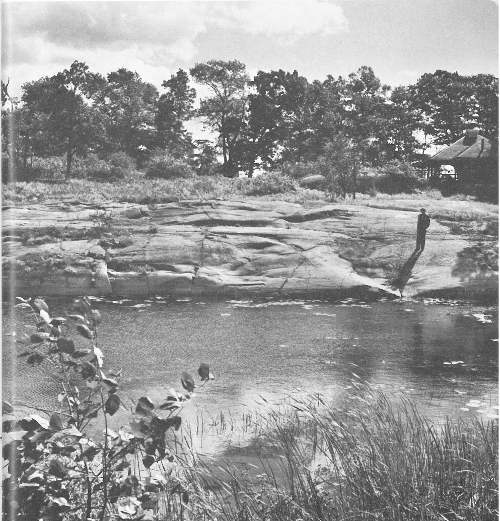
Smooth, glaciated surfaces of granite feature this beautiful inlet on Beau Rivage Island just southwest of the dock.
The great mass of ice pushing over the face of the land scraped everything loose before it. Soils were torn up and carried away. Great blocks of solid rock were plucked from the earth and carried off to be dropped again, perhaps many miles away. The bedrock was scraped clean and polished by the moving ice which was studded with boulders and debris frozen into it. Hills were rounded off and old river valleys were scoured out.
As the ice melted, the materials that it carried were deposited in a scattered manner all over the country. Piles of rock debris and old soils were dumped here and there, making hills in some places, filling valleys in others, and generally disrupting the drainage. Some of the rocky hills we see today were scraped bare by the moving ice and left naked when it melted, except for scattered boulders lying here and there.
As the last ice-sheet receded from its southernmost penetration, some distance south of what is now the Great Lakes system, it unveiled a country that had been very much changed by glacial deposits. River valleys that formerly drained some of the lowland areas where the Great Lakes now lie were dammed up by vast heaps of glacial debris. Lakes formed between the front of the glacial ice to the north and the mounds of glacial debris and higher lands to the south.
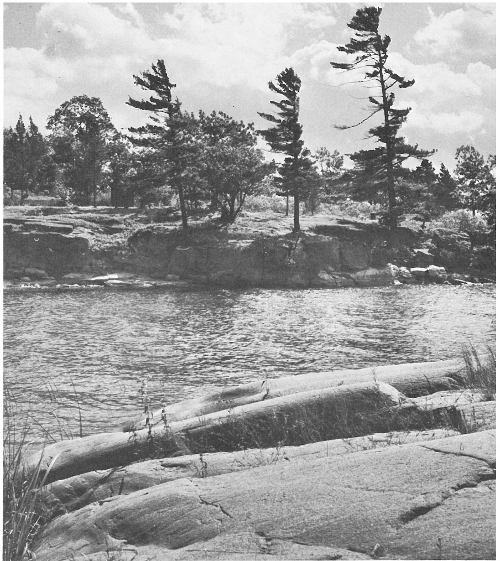
The southwest end of Beau Rivage Island displays surfaces of dark granitic rocks that were smoothed, rounded and scratched by the passing of the glaciers in the recent geological past. Since the glacial age, some of the rock surfaces have weathered and some large blocks have been loosened by frost action.
For brief periods these lakes along the ice-front drained to the south. Lake Ontario at various times drained out of its southwest corner toward the Mississippi River system and southeastward into the Mohawk and Hudson River valleys. Finally the main icecap melted back far enough to uncover what is now the St. Lawrence River valley, and water from the Lake Ontario basin flowed out this way to the Atlantic Ocean.
A complicating factor in the history of development of the Great Lakes was the changing of the land level due to the enormous weight of the icecap in this part of northern North America. It seems almost inconceivable to us, who think of the earth as a solid unyielding mass, to think that even under the weight of several thousand feet of ice over a very long period of time, its surface could actually buckle or bend. This certainly seems to have happened, for since the ice was removed the land has been rising slowly in stages. This is rather like pressing your finger into a piece of tar for a long time, gradually making an indentation. When your finger is removed nothing seems to happen, but over a period of time the dimple will even out again. Depression of the land due to the weight of the glaciers, and its later slow rebound after the ice melted, are very well observed in the Baltic countries.
When Lake Ontario first took on its present shape and size the sea had flooded onto the depressed land surface all the way up the valley of the St. Lawrence River to near Brockville. This expanded arm of the sea-called the ‘Champlain Sea’—has left its mark in the form of beaches, terraces and deposits of clay along the sides of the present St. Lawrence River, the Ottawa River and the Lake Champlain area. Thus Lake Ontario first drained into the sea from an outlet that [15] was much closer to the sea than it is now. Since then, uplift of the land has drained the sea from the upper end of the St. Lawrence Valley and has thus lengthened the river.
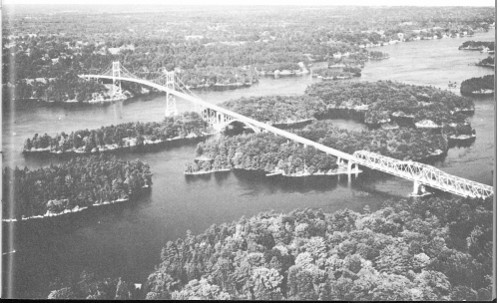
In this aerial view where the Thousand Islands Bridge crosses the St. Lawrence River you get a good idea of how the islands originated by flooding of an irregular topography. The growth of the woods right down to the water gives this region a much different look from shore areas where waves keep wider margins of the shoreline clean.
The Thousand Islands were formed when the water from the Great Lakes system was forced to flood out over the land to find an outlet to the sea. It was forced to do this because the preglacial drainage systems had been very much interfered with by great deposits of glacial debris and differential warping of the land in the manner described above. The Thousand Islands area, therefore, is flooded land. What [16] formerly were hills now stand out as islands or form shoal regions, and old valleys and depressions are now found as deeper parts of the river. The reason for the great number of islands here is that this was a very irregular surface that was flooded only part way; most of the hills have been isolated, yet not completely covered.
Thus we see that the scenery in the Thousand Islands owes its origin to the ancient rocks, the manner in which they were eroded in preglacial and glacial times, the disruption of old drainage systems and the flooding of the land in the very recent geological past.
A map of Lake Huron and its environs shows that the area comprises two distinct parts: the main body of Lake Huron to the southwest and Georgian Bay to the northeast. This is because two separate valley systems have been filled with water in recent geological times. In turn the northern and northeastern shores of Georgian Bay are quite different in general scenic aspect from the other shores of Lake Huron. This is because the rocks are different; and because the islands of Georgian Bay Islands National Park occur very near the boundary of these two rock types, a knowledge of the rock history will help us to understand the scenery better in that part of Georgian Bay.
A very large area of eastern and central Canada is underlain by ancient rocks which are mostly granite and granite-gneiss with patches here and there of much-altered sedimentary and volcanic rocks. These are all of ‘Precambrian’ age—they are more than 600 million years old, and may be as much as 3 billion years old—predating almost all life on the face of the earth. This great area is known as the ‘Canadian Shield’.
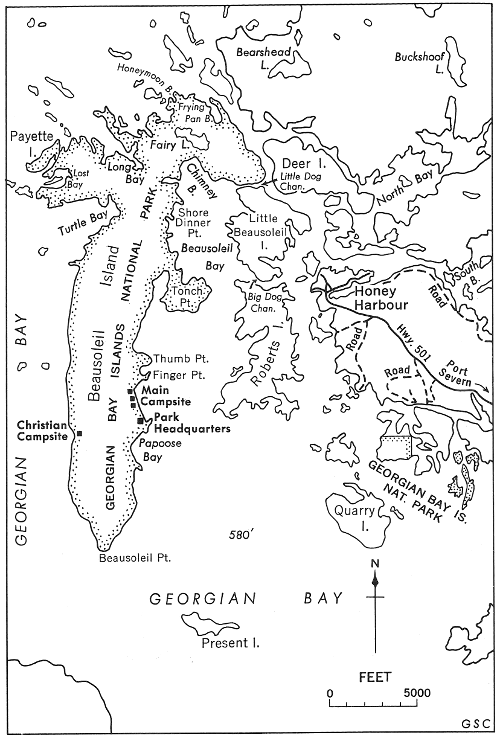
GEORGIAN BAY
The ancient rocks of North America were eroded in Precambrian times to a more or less flat, even surface. About 500 million years ago, oceans began to flood the continent and they overlapped onto this ancient surface. Sand, mud and limy mud were deposited in layers over the bottom of the ancient sea. These sedimentary materials eventually hardened into solid rock and when the seas withdrew they were left as we find them today in the form of sandstone, conglomerate, shale and limestone, lying on top of the ancient Precambrian surface. The processes of erosion have gradually stripped back this overlying cover to expose more and more of the old rocks beneath.
Part of the boundary line between the large areas of ancient rocks to the northeast and the overlying blanket of younger rocks to the southwest is covered by Georgian Bay. Georgian Bay Islands National Park lies near the southeastern end of Georgian Bay, very close to this boundary. The islands themselves are made up almost exclusively of the ancient rocks with only one very small patch of the younger rocks known.
It is interesting to note the differences between the northeast side and the southwest side of that part of Georgian Bay where the park is located. The northeast shore is an archipelago filled with all shapes and sizes of islands scattered along a deeply indented shoreline. By contrast the southwest shore, just across the narrow end of Georgian Bay, is a smooth shoreline with a few large indentations and hardly any islands at all. The rocks along the north side face the water for the most part in smooth rounded surfaces, whereas cliffs of nearly flat, bedded rocks are common on the southwest side. Now let’s take a closer look at some of the rocks.
The ancient rocks on the northeast side of Georgian Bay were first studied by Alexander Murray in the 1850’s. As we stand on the beaches and points there now and wonder about the rocks and scenery it is interesting to think that more than 100 years ago the pioneer geologists of Canada stepped ashore from their canoes and surveyed the same scenes. What they saw was an array of pink granite, pink and grey granite-gneisses or banded rocks, dark gneisses in some variety, and various small veins and tabular masses of light and dark dyke rocks.
Granites begin deep below the surface of the earth as masses of molten rock that may have come from even deeper in the earth or from the melting of other rocks in place. Great stresses inside the earth may force them into other rocks, thrusting them aside to make room. After a long period of cooling the molten granite solidifies to form a homogeneous, massive rock which may be broken here and there by cracks, due to shrinking, called ‘joints’. The most common minerals are quartz, which is very hard and of glassy appearance; feldspar, which may be pink or white and breaks with flat surfaces; and tiny clots of dark minerals that may include black biotite mica or needle-like hornblende. Pink granites occupy large areas in the Georgian Bay Islands district. Granite-gneisses may be formed in two ways. If a gradually cooling granite is given a squeeze when it is partly crystallized, the minerals may be drawn into layers to form a banded structure. On completion of the cooling a banded granite-gneiss may be the result. Granite-gneisses are also formed when certain types of sedimentary rocks, old granites, or old partly altered rocks are subjected to heat and differential pressures. The whole mass may become partly plastic and new minerals may develop. These often become strung out in parallel bands, thus producing, once again, a gneissic structure.
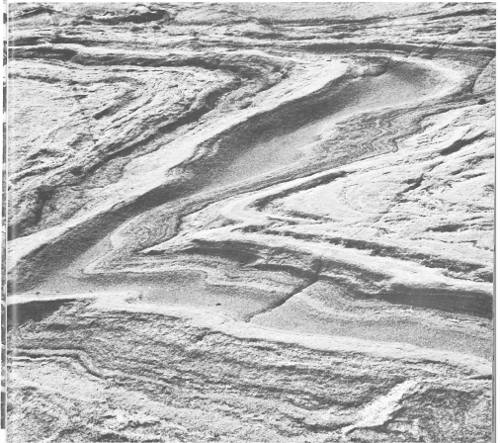
A superb display of folded and contorted, dark hornblendic gneisses is to be seen at the wharf at Shore Dinner Point campsite on the eastern side of Beausoleil Island. The folded structure, the layers of different composition, and the differential etching or erosion of the layers are all clearly visible here. The pencil just below and to the right of centre gives the scale.
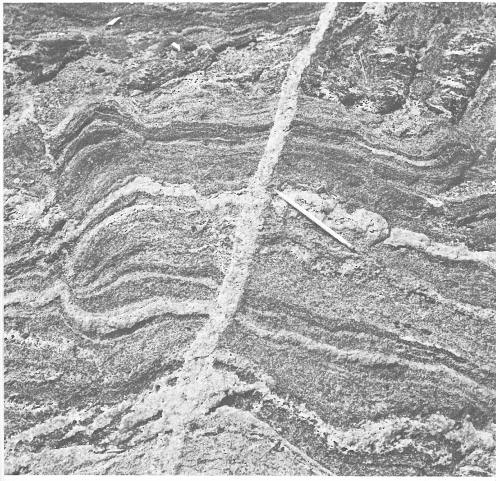
A detailed view of banded gneisses at Shore Dinner Point shows the mixture of white and dark minerals in all the bands and their segregation into layers. The light bands are made of quartz and feldspar and the dark bands are rich in hornblende and biotite. After these gneisses were formed, a thin vein of quartz and feldspar intruded the older rocks and now makes a crosscutting rib.
Dark gneisses may begin as sedimentary rocks which are high in iron and magnesium, as volcanic rocks, or even as dark igneous rocks. Prolonged heating and squeezing may eventually produce highly banded rocks with assemblages of entirely new dark minerals.
‘Dyke’ rocks appear to represent the last stages in the igneous history of many areas. The last part of the liquid rock is squeezed into cracks and fissures in the already consolidated igneous rock and in the marginal rocks to form thin tabular masses of a variety of compositions. These dykes, whose thickness may be a tiny fraction of an inch or even several tens of feet, may be seen in many places in the Georgian Bay Islands region.
Aerial photographs of Beausoleil Island show a general evenness of pattern over the whole island as far as the narrowing between Turtle Bay and Shore Dinner Point. This area is underlain by granite and granite-gneiss. North of the narrowing, however, a strongly marked pattern is visible on photographs and it may even be distinguished on ordinary maps by the unusual shape of the shoreline there. Elongated islands and points, deep coves, and the hills on the land all form a strongly curved pattern centred about Payette Island at the northwest corner. It extends on across the land to the region of Shore Dinner Point and the head of Beausoleil Bay. This patterned area differs from the rest of Beausoleil Island both to the south and to the northeast because it is underlain by dark banded gneisses which weather to produce ridges and valleys. If you go to the northwest corner of Beausoleil Island you will be able to see the difference in rocks immediately.
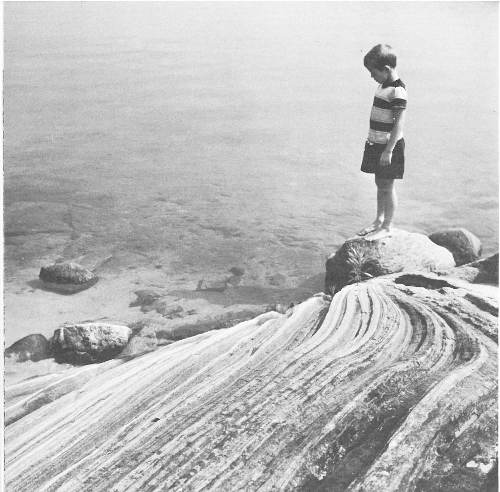
This small boy at The Oaks campsite is standing on a glacial boulder looking through clear water at the sandy bottom. Pointing at him is a sweep of the banded gneisses shown in the close-up view on the next page.
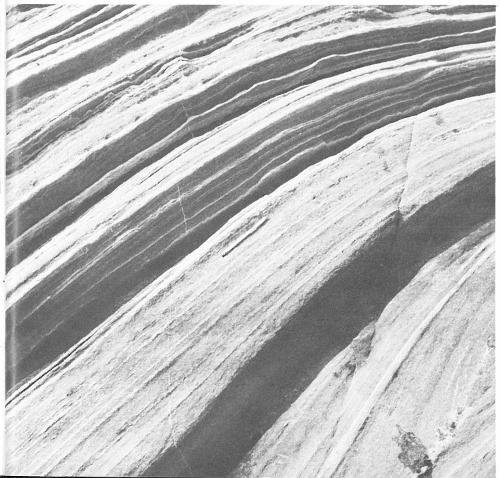
Bands of alternating feldspar-rich and hornblende-rich gneiss present different resistances to erosion. You can see how differential etching has produced a very strongly striped appearance. A very thin white vein of quartz passes just to the left of the pencil in the centre.
Some of the walks and stonework in and around the park headquarters on Beausoleil Island are made of flat slabs of sandy limestone. These were obtained on the west side of the island near Christian campsite. A walk of a little more than a mile across the island to that area will take you to a beautiful shore where the surface features are quite different from those in other parts of the island. Cobbles and pebbles along the beach, particularly on the northern end, are very commonly composed of sandy limestone. A walk northward along the shoreline a few hundred yards will take you to an area where many of the large boulders are of the same sandy limestone. Some years ago a small amount of stripping and excavation here provided a source of the flat limestone slabs mentioned earlier. One can only conclude from this that the younger sedimentary-rock cover, exposed so widely to the southeast, blankets a small low area on Beausoleil Island in this vicinity.
The great icecap that covered most of northern North America with a sheet of moving ice profoundly altered the scenery in what is now the Georgian Bay area. The kind of surface on the rocks and the shape of the land are the result of the glaciation, as is Lake Huron itself in its present form.
Before the glaciers came, the region north of Georgian Bay probably consisted of a number of river valleys that drained the area of ancient rocks lying to the north and flowed across the uplifted edges of the marginal younger sedimentary rocks to the southwest. A major drainage system probably ran along the actual boundary between the sedimentary rocks and the ancient shield where Georgian Bay is now. As erosion continued, the overlying sedimentary rocks were gradually stripped off to reveal a gently undulating surface on which the sedimentary rock cover was laid down, perhaps 500 million years before.
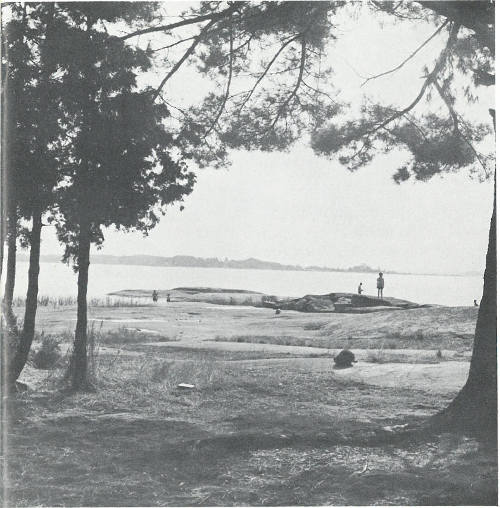
Smooth, rounded, glaciated surfaces on Finger Point near the main campsite on Beausoleil Island are typical of those found all over northeastern Georgian Bay. The original glacial scratches have been removed from most of these surfaces by slow erosive processes, but they still show channeling and gouging. Glacial boulders and ice-rafted boulders are perched on the solid rock surface.
When the climate gradually became cooler, great glaciers formed to the north and gradually pushed southward, covering all of this area. The movement of the ice pushed off old soils, plucked large boulders and abraded the surface with sand grains, pebbles and boulders frozen into the bottom of the ice. Rock surfaces were smoothed and polished and grooved in exactly the same manner that may be observed even now on mountains where glaciers are active or in Greenland and Antarctica.
When the icecap melted back because of a warming of the climate the rock debris being carried by the ice was left scattered over the countryside. Valleys were partly filled, boulders were left scattered here and there and large areas of bare rocks were left open to the weather. The patterns of movement of the ice were clearly marked on the country in the form of scratched and channelled rock surfaces and in the distribution of the boulders picked up by the ice and carried off to the south.
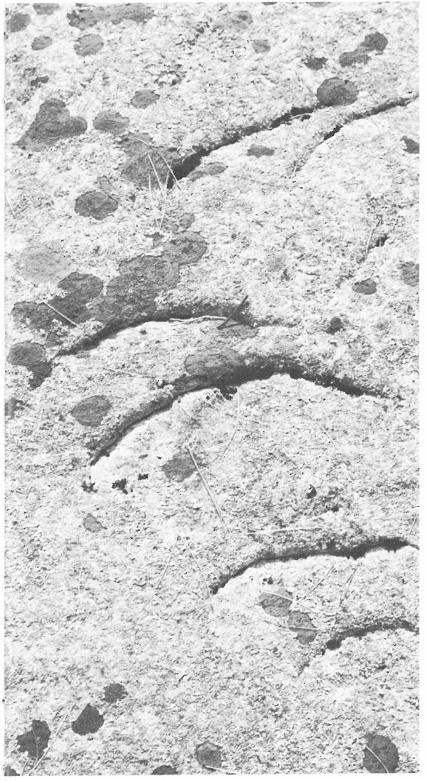
When the glaciers pushed over the land they sometimes broke the surface of the rock into crescentic fractures like these on the north end of Beausoleil Island. The ice here moved from the lower right corner toward the upper left corner. A variety of mosses and lichens covers the surface of this granite-gneiss.
Scratching and grooving are visible on nearly all rock outcrops around the shores of Beausoleil Island. The country to the southwest of Georgian Bay is littered with boulders, cobbles and small pieces of the rocks from the granite and gneiss to the north of the boundary line between the sedimentary and older rocks. On the other hand no such boulders of sedimentary rocks from the southwest are found lying on the older bedrocks to the northeast.
Beausoleil Island and the others in Georgian Bay Islands National Park and the surrounding region offer shoreline scenery as their principal attraction. The shorelines and everything about them are the results of the glaciation. The sand along the beaches is glacial sand that was scraped and scoured from the surface of the land by the moving glaciers, then dumped when the ice melted. Wave action of Lake Huron has since washed the sands clean and concentrated particles of different sizes in different places so that beautiful sandy beaches now alternate with bouldery shores. The fingers of rock sticking out into the waters of Lake Huron as points or islands were thoroughly rounded and smoothed by the passing of the ice. The large boulders that line the west shore of Beausoleil Island from Turtle Bay to its southern point were picked up by moving ice from the solid rock somewhere to the north. The fact that there is a shoreline at all is due to the formation of the present Lake Huron as a direct result of the glacial age (see below).
Inland on Beausoleil Island the work of the glaciers is everywhere evident. Glacial boulders up to 12 feet long poke out of the forest cover in many places. The central ridge of the middle and southern parts of Beausoleil Island is an [31] accumulation of glacial debris collected under the melted ice or perhaps along one margin of it. You can see something of the structure of the interior of the ridge by looking into the gravel and sand pit just southwest of the park headquarters area. Fairy Lake, at the northern end of the island, lies in a basin that was scooped and hollowed out by the ice and then dammed by glacial debris.
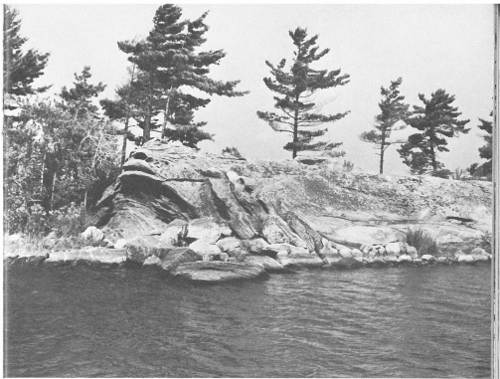
Pine trees grow in cracks and crevices in the granite-gneisses here on a small island in Beausoleil Bay. The low cliff at the left end of the ridge shows that the gneisses have a general up-arched structure. The boulders came from three different sources—some are from the erosion of the rock on the island, some were brought in by the glaciers long ago, and some have been rafted along the shore by the ice of Lake Huron.
To us who have lived all our lives in the presence of lakes as large as the Great Lakes it is indeed hard to imagine what the country was like before the lakes were there. Abundant evidence suggests that before the coming of the glaciers, the Great Lakes, as we know them, had not yet appeared. It seems very likely that before the glacial age began, about a million years ago, the Great Lakes region consisted of a number of basins with through-going river systems draining generally to the south. When the glaciers melted, masses of glacial rubbish derived from old soils, and blocks and pieces of rock, were dumped near the southern limit of glaciation. This we know to have been not far south of the present southern margin of the Great Lakes. Thus the old southward-draining river systems were partly or wholly dammed by glacial deposits.
A second effect of the enormous mass of ice was the actual pushing down or depression of the land which it covered. We ordinarily think of the surface of the earth as being a completely resistant solid—it may shake a little from earthquakes but we generally consider it to be irresistibly firm. However, from different parts of the world we know that large segments of the earth’s crust rise and fall in adjustment to the load on top or to internal forces which are not entirely understood. In most places it is agreed that very large loads, such as the Mississippi delta or a great icecap thousands of feet thick, actually depress the land very slowly over thousands of years. When this weight is removed, as the weight [33] of an icecap is when it melts, the land should gradually rebound. This is what has happened in the Baltic area and all along the southeastern part of the area covered by the North American ice-sheet. Thus large basins were filled with water after the icecap had left the region of the present Great Lakes because of the damming of the natural drainage to the south and the depression of land.
The Great Lakes had a highly varied history before they took their present shapes. The lakes first formed when the basins in which they are now located were first exposed along the southern margins of the melting icecap. They had shapes entirely different from those we now know for they were bounded on the south by glacial dams and on the north by the front of the ice itself. At this time the icecap covered and completely blocked the present drainage system out the St. Lawrence River. This meant that the ancestors of the present Great Lakes had to drain southward at a much higher level than now. As the ice-front gradually receded, lower and lower outlets were uncovered so that the levels of the ancient lakes gradually dropped. The old lakes, however, left their marks on the land in the forms of beaches and terraces cut and modified by the waves at various levels. At last, thousands of years after they began, the Great Lakes took their present shapes and approximate sizes.
Remnants of old lake levels may be seen in many places around Lake Huron and Georgian Bay. On Beausoleil Island itself, flat terrace-like areas are almost certainly reminders of the former higher levels of Lake Huron. It is interesting to think that Beausoleil Island started off very much smaller [34] than it is now and that many of the islands around it were under water in the earlier stages of the development of Lake Huron. The islands that were already poking their heads out of the water gradually got larger as the water level went down, and numerous other islands made their appearance.
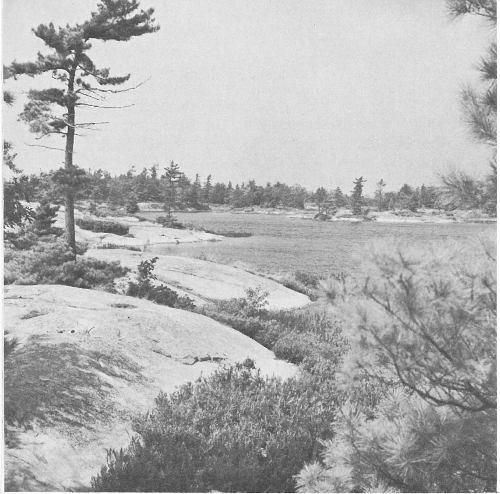
Fairy Lake lies in a rock basin at the northern end of Beausoleil Island. Smooth round ‘boiler plates’ of ancient granites and gneisses line the shore and support the typical Georgian Bay pines.
Thus you see that the area of the Georgian Bay Islands is essentially a drowned-land topography. Hills and mountains now form islands or shoals while old valleys form indentations or the deeper-water bottoms of bays. Rivers on the land behind the shore follow the old preglacial drainage systems where they can; they form lakes behind dams of glacial material and waterfalls where they tumble into old valleys or flow over accumulations of glacial boulders. They enter the lake at the heads of estuaries or long indentations because of the drowning of the land. The island-studded, highly indented shoreline on the northeast side of Georgian Bay contrasts with the smoother shoreline to the southwest because different kinds of landscapes were submerged. Numerous irregularities in the form of hills and valleys on the northeast made an irregular shoreline with lots of islands. On the other hand, the surface of the land on the south side was very smooth, with very few bumps and hollows; only the few broad shallow valleys developed on the sedimentary rock cover resulted in indentations in an otherwise very smooth shoreline.
Erosion—Rocks are attacked by processes of weathering and erosion as soon as they are exposed at the surface. Water gets into pores and minute cracks and with freezing and thawing gradually splits off fragments of the rock or individual mineral grains. Chemical changes in some of the minerals result in changes in volume, which in turn tend to break up the surface of the rock. Plants send down tiny rootlets that grow and split rocks apart. Waves along the shore wash off the fragments which are loosened by frost or chemical changes. Waves also abrade by throwing sand grains, pebbles or even cobbles and boulders against the solid rock. In mixed deposits consisting of boulders, cobbles, sand and clay particles, the waves promptly start to sort the particles according to size and kind, forming fine sand beaches in some places and leaving heaps of boulders in others.
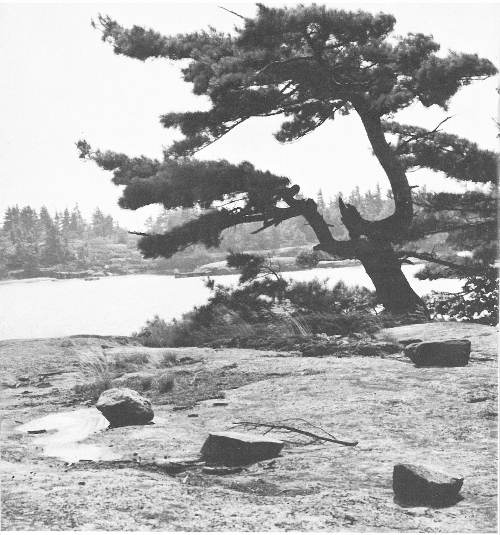
This strange-looking wind-blown pine has put its roots into the cracks in the gneisses on the north end of Beausoleil Island. The glaciated surface in the foreground is covered with odd boulders which are glacial debris. On the point in the background, rounded glaciated ridges of gneiss are visible.
Waves have not been able to make much impression on the solid rocks of the Georgian Bay area in the few thousand years since the formation of Lake Huron. This is partly because erosion of resistant rocks is a slow process and because the level of wave attack has been changing as the level of Lake Huron changes from time to time. The freezing of the lake in the winter and the drifting of the resulting ice in spring has undoubtedly caused some erosion as wind blows the ice heavily against the land or as the large ice-cakes float off boulders and pieces of rock from the shorelines. Thus the smooth and rounded surfaces of the rock meet the water nearly unchanged from the way they were left by the glaciers some 8,000 to 10,000 years ago. Finger Point at the main campsite on Beausoleil Island shows this well as do most rocky points in the neighborhood.
Beaches—Ripple-marks are best developed on medium-grained sands in shallow-water areas where waves are active. The beach in front of the main campsite area of Beausoleil Island is a good place to see them forming and see how their pattern and composition vary from place to place.
Ripple-marks are formed by the rhythmic back-and-forth variation in currents which accompanies the passing of waves, and also by continuous or discontinuous currents. It seems that rippled surfaces represent an equilibrium condition and that the slightest changes in waves or currents will produce immediate changes in the shape and pattern of the ripples themselves.
You can wade out anywhere along this beach and see the process of ripple formation and change in operation. As any one wave moves in over the shallow water it disturbs the bottom sediment in two separate currents—one going with the forward motion of the wave and the other moving in the opposite direction. Watch how the water is clouded with sand and silt as the wave moves forward and again as it moves backward; in each case the bottom is first scoured and then deposited upon.
The shape of the ripples produced by any particular set of waves depends on many factors but really comes down to whether the forward scour and fill is balanced by the backward scour and fill. Symmetrical ripples with one side exactly the mirror image of the other are produced if the two are about equal. If one current is sharper or stronger than the other, then asymmetrical ripples—those with one long gentle slope and one short steep slope—will be formed. Most of the ripples found on beaches are asymmetrical because the forward and backward motions in the waves are not equal in intensity or duration. You can see this action for yourself by simply wading out and looking at it going on round your feet.
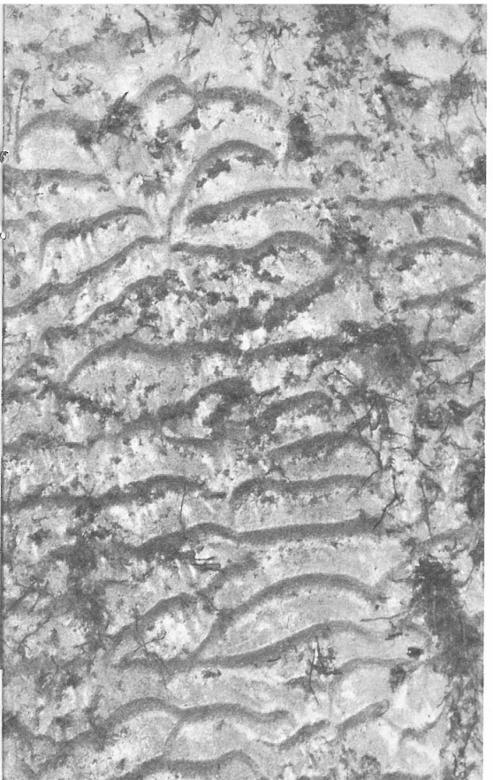
Waves in shallow water throw up the bottom sands into rippled surfaces. The wash of the current back and forth often segregates the mineral grains, according to their density, in different parts of the ripple structure. Silvery mica flakes on the back slopes give an unusual appearance to these ripples on the beach of the main campsite near Finger Point.
Another feature of ripples is the way the patterns change with slight interferences such as a boulder or even a boat, either aground or afloat in shallow water. The ripples for several feet around may be changed.
Separation of mineral grains in the sand often results from the washing back and forth on the surface of the ripples. The main beach at Beausoleil Island shows some ripples with [40] silvery mica grains concentrated on their long back slopes. In other parts of the beach, reddish garnet and black magnetite are similarly segregated but are concentrated more along or near the tops of the ripples.
If you walk along the beach or in the water just off shore you will recognize other shapes of ripples. Some show flattening of their crests because of changes in the character of the waves or shallowing of the water. Some show minute troughs along their crests or even series of subsidiary wrinkles along their top surfaces. In plan view the ripples show an endless variation of parallel and joining patterns.
At and above the waveline along the beaches, similar segregation of the minerals may be observed. Some parts of the beach at the main campsite are darkened by the accumulation of grains of magnetite; other parts have a reddish tinge because garnet is mixed with the magnetite. The magnetite and garnet are both heavier than the quartz grains which make up most of the sand and thus are commonly found together.
Georgian Bay Islands National Park is located in an island archipelago formed in post-glacial times by flooding of the land along the margin of the Canadian Shield. Besides scenery of great beauty it offers a chance to see features of glacial history and displays of granitic and gneissic rocks of several varieties; and while swimming or paddling along the shore you can see ripple-marks forming and reforming, the segregation of different kinds of sand particles, and a variety of beach processes at work.
More than half of Canada is underlain by ancient rocks which are now in the form of granite and granite-gneiss, with small patches of much-altered sedimentary and volcanic rocks. This enormous area, which occupies approximately the northeastern quadrant of North America, is known as the ‘Canadian Shield’. Its rocks are all more than 600 million years old, perhaps as old as 3 billion years, and are said to be of ‘Precambrian’ age. Younger rocks of sedimentary origin overlap the Shield all around its margin. And one of the places where this overlapping takes place is along the line from the centre of Georgian Bay and its southern end eastward toward Kingston. All the bedrock at the surface south and southwest of this line is of the younger sedimentary series. Bruce Peninsula lies approximately 40 miles southwest of the boundary lines, so it is well inside the area underlain by the overlapping younger rocks.
Evidence in the sedimentary rocks of the region, and on the surface of the old rocks to the north, shows that in Ordovician times (about 500 million years ago) a marine inundation covered the eroded surface of the ancient Precambrian rocks. Great quantities of sand and limy mud were deposited by the encroaching seas. In the next 200 million years successive seas laid down sedimentary rock units layer upon layer. Thus geologists now recognize sedimentary rocks of Ordovician, Silurian and Devonian ages in succession, with each of these names referring to succeeding periods in geological history.
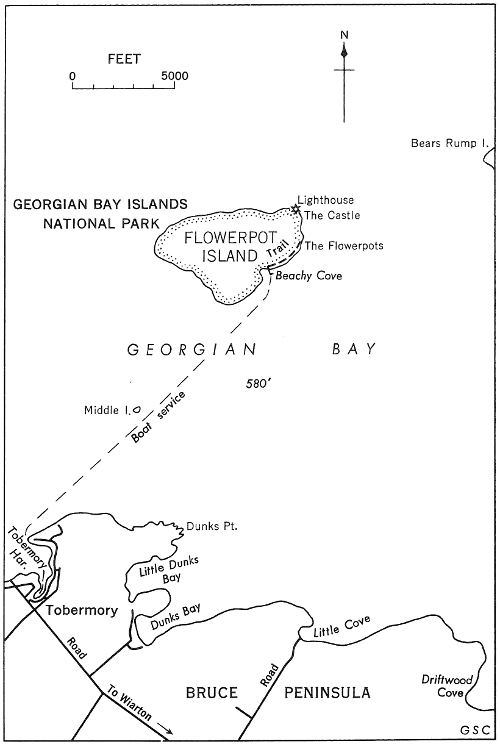
GEORGIAN BAY ISLANDS NATIONAL PARK
In recent geological times, hundreds of millions of years after these marine rocks were laid down, the whole of northern North America has been steadily eroded by streams. This has resulted in a gradual stripping off of the sedimentary cover on the Canadian Shield. Around the edges of the Shield we now find the overlapping marginal sedimentary rocks with the oldest closest to the Shield and progressively younger ones as we travel away from it. In some ways this is like tearing paper off a well-wrapped package. When the package finally shows through you can see the layers of paper along the edges of the tear with the outermost layers farthest from the hole.
Thus the oldest rocks of the sedimentary section in southern Ontario are Ordovician rocks found along the northern side of Manitoulin Island and from the southeastern corner of Georgian Bay across to Lake Ontario. The southern side of Manitoulin Island, Bruce Peninsula, and a belt that runs southwestward across the peninsula toward the Niagara Falls region are of younger Silurian rocks. Still farther to the southwest a belt of Devonian rocks overlies these. Flowerpot Island lies at the tip of Bruce Peninsula in the belt of limestones of Silurian age that may be traced to Manitoulin Island to the northwest and as an escarpment southeastward through Bruce Peninsula and southwestern Ontario all the way to the very lip of Niagara Falls.
The rocks overlapping the Canadian Shield have been very little disturbed since they were first laid down as sediments at the bottom of the sea. So we find them today as very nearly horizontal layers with no large folds or fractures through them. The rock, however, is broken along joint faces which may be due partly to shrinkage caused when water was squeezed out of the original sedimentary material, and partly to very minor disturbance of the rocks as they were uplifted at various times in their geological past.
Lake Huron first began as a ponding of water between the front of a great icecap on the north side and the vast dam of glacial deposits and bulged-up land on the south side of the present lake basin. As the ice gradually melted to the north, the lake expanded. On the other hand, as the ice withdrew to the north it uncovered valleys that provided drainage at various levels for the ancestral Lake Huron. A further complicating factor in the history of the lake levels was the effect of the enormous weight of the icecap on the land. This mass of ice, thousands of feet thick, actually depressed the land very slowly. As the ice withdrew the weight was removed, and the land gradually began to rebound. This, naturally, has had an effect on the levels of Lake Huron.
The overall result of these happenings has been Lake Huron’s gradual withdrawal from a higher level to a lower level, with some temporary halts. And at each one of these stopping places or former levels the waves cut into the land, forming [45] beaches and cliffs. These former shorelines are now high and dry.
As you approach Flowerpot Island from any direction you can see at once that there is an upper mass of heavy-looking grey limestone and a lower section made of much more obviously layered or bedded limestone. (The word ‘limestone’, which actually means a rock made up chiefly of calcium carbonate, is used in a broad sense here. Some of the rock layers are sandy limestones and many of them consist largely of ‘dolomite’ which differs from limestone in that it contains the magnesium-rich mineral dolomite.)
The massive upper layers have been more resistant to erosion and commonly form cliffs around the island. Their erosion has been by undermining and eventual collapse along more or less vertical joint surfaces. In some parts of Flowerpot Island this has produced a strong terrace effect.
The dock area is on the eastern side of Flowerpot Island and the rocks at this level are all in the lower, well-bedded limestone. From the dock area you can see the cliffs of the upper, massive limestone in the hills all around. As you start walking along the shore toward the flowerpots themselves you will notice at once the flat slabs of very light grey or white limestone along the shore. These have been stripped off by wave erosion or split off from cliffs by frost action and then arranged along the beaches by the waves and currents.
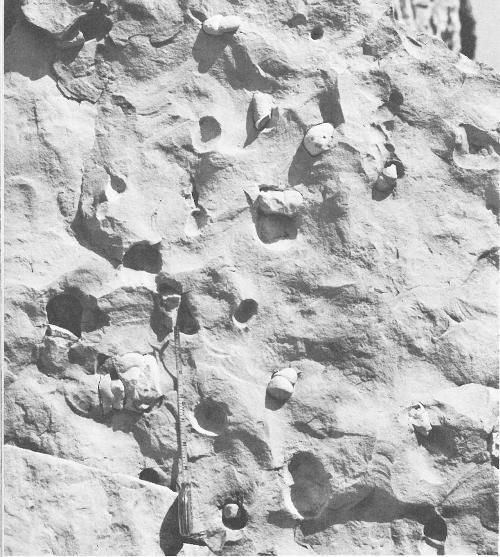
The nearly flat limestones exposed between the landing dock and the main flowerpots on Flowerpot Island are light grey to white in fresh exposures and bleached to a dazzling white on weathered surfaces. Some of the limestone surfaces show features of shallow-water deposition, such as ripple structures; others contain numerous nodules, slightly different in composition from the rest of the rock, which weather out, as in this slab.
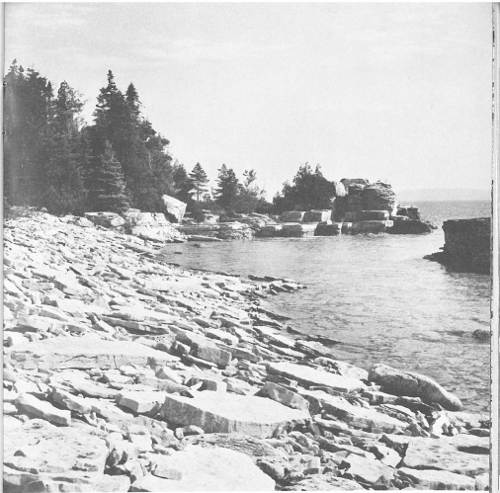
The beach just beyond the landing wharf on Flowerpot Island shows very well the imbricate effect made by waves on flat slabs of loose limestone. The slabs lie more or less like shingles on a roof, one overlapping another. The jointed limestones of the solid bedrock crop out in the point in the background.
Any beach covered by flat slabs commonly has an ‘imbricate structure’—that is, the slabs overlap one another rather like the shingles on a roof. This happens because the forward wash of the waves is stronger than the backward wash and boulders or slabs that lie overlapping in the wrong direction are quickly turned over. The whole beach gradually becomes imbricated.
The path toward the flowerpots presents occasional glimpses of rocky points which are made of flat, layered limestones cut by vertical breaks or joints. Flat surfaces of solid rock here and there on the shore show where wave action has stripped off the overlying layers to a particularly hard layer. It is interesting to think that these flat surfaces of limestone formed the bottom of the sea perhaps 450 million years ago and that this is the second time in a long geological history that waves and currents have washed over them.
A walk of a few hundred yards from the dock brings you to a view of the flowerpots themselves. These vertical pillars of rock are clearly layered in exactly the same way as the rocks on which they stand and the rock forming the cliffs just in back of them. Closer examination of the flowerpots and the cliffs behind them will show that individual rock layers in the flowerpots can be identified in corresponding positions in the cliffs. The flowerpots are erosional remnants left behind as wave action wore away the land. The tops of both flowerpots are a little larger than the bottoms because they are made of slightly heavier or more massive limestone, and because the waves are more active at the lower levels. Once isolated entirely from the land these pillars would be ground away at the bottom. As a matter of fact you will find that some patching of the natural flowerpots has been done by the park authorities to prevent the normal course of erosion from undercutting them to the extent that they would fall over and disappear. Small caps of concrete have also been placed on their tops to cut down the rate of erosion by water solution and frost action in the cracks and joints.
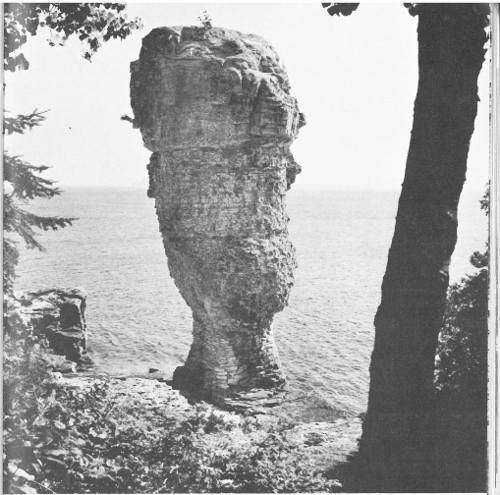
The main flowerpot is this tall stack made of thin-bedded limestone on the bottom with a more thickly bedded unit on the top. To preserve this natural feature, some masonry work has been done around the bottom and a waterproof capping of concrete placed on top. In the normal course of events it would have been eroded away by this time.
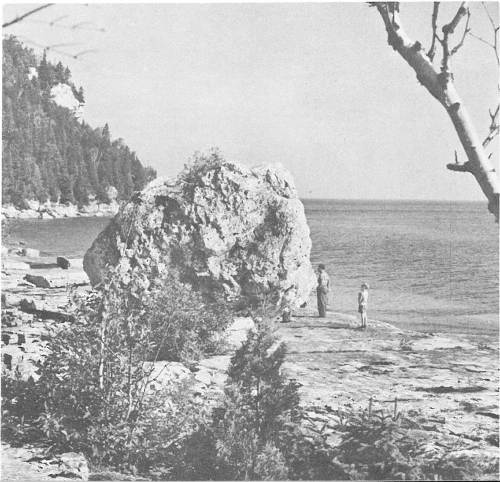
The flat-lying limestones near water level just beyond the flowerpots support this very large irregular boulder that has fallen from the massive cliffs above. Several more of these big boulders lie teetering near the edge of the cliffs just in from the shore.

These two undergraduate geologists are examining the contact between the thin-bedded limestone and the more massive-bedded limestone overlying it. It is of these two rock units that the flowerpots are made.
A little farther to the north beyond the flowerpots you can see places where wave action is cutting away at the cliffs along joints and fractures. In one or two places you may see that the way the rocks are being eroded makes it look as if new flowerpots are in the making there.
Caves are featured along the walk on the east side of Flowerpot Island in the region of the flowerpots. If you crawl into one of them—and most of them go back for a distance of a few tens of feet—you will be impressed by the cool air and the same feeling of awe which has always come to men going into caves. You may note that these caves all occur at or near the base of the upper, massive limestone unit that is found all around the top of Flowerpot Island. This unit comes down very close to shore level at the southern end of the island because of the very gentle southerly dip of the rock formations. Here you can see that wave action is even now cutting into the massive limestone to produce hollows and small caves.
It is almost certain that all the caves exposed along the edges of the cliffs on Flowerpot Island were formed by wave action at a time when the water level of Lake Huron stood higher than it does now. The position of the caves along the outside edges of the island, the absence of any large quantities of water which could dissolve out the limestone to form the caves there now, and the known history of higher levels in Lake Huron all make this a reasonable explanation of their origin.
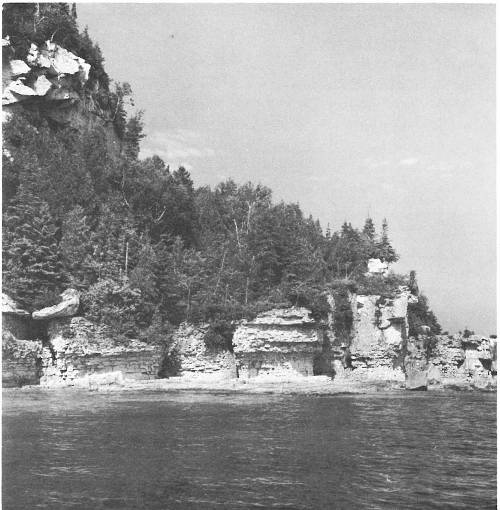
On this point northwest of the main flowerpots, the cliffs of flat limestones are being eroded along joints by waves; some of the pillars thus formed may be left behind to make new flowerpots. A part of the massive rock layer in which the caves are cut in various places on the island forms a cliff in the upper left corner.
Proof of the former higher levels of Lake Huron may be seen in the terraced beaches that rise like a flight of steps in the cove on the north side of Flowerpot Island where the lightkeepers’ houses are situated. Similar evidence found all around Lake Huron reflects the stages in the development of the present lake.
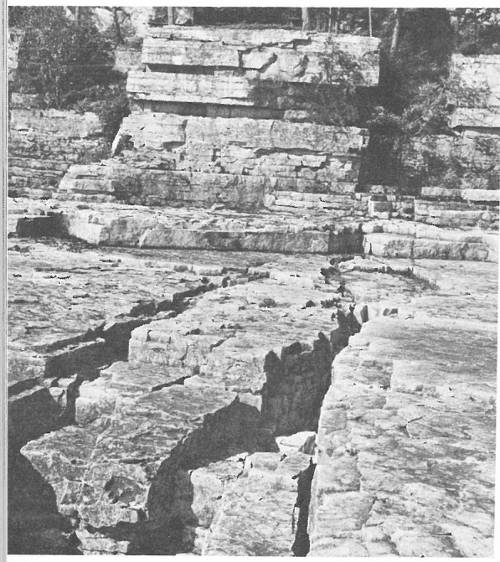
Flat-lying beds of limestone just beyond one of the flowerpots show these vertical gaps. They are joint surfaces that have been dissolved and eroded to produce these cracks which run across the flat rock bench.
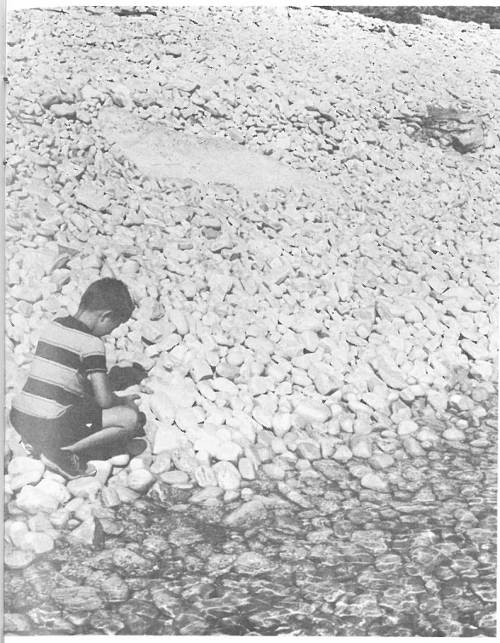
The beach beyond the flowerpots is made of limestone cobbles. These have come from ragged irregular fragments of the limestones nearby and are now very much rounded by wave action. The small waves in the foreground diffract the light to make the peculiar pattern in the water.
Flowerpot Island is built of flat-lying limestone and sandy dolomitic limestone. Erosion has been at various levels on the island as the level of the post-glacial Lake Huron gradually went down. Thus terraces and caves cut by the waves in other times are now found well above present water level. Waves are still cutting into the limestones and have left behind two unusual remnants—the flowerpots—which give the island its name.
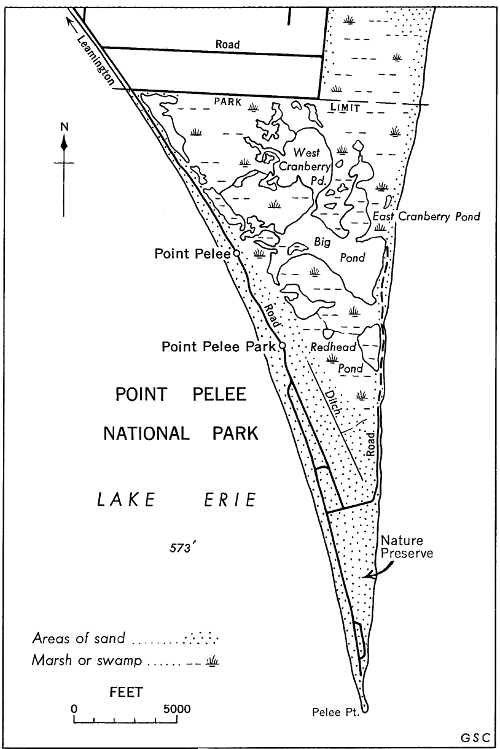
POINT PELEE NATIONAL PARK
Point Pelee is in the extreme southwestern part of Ontario, about 6 miles south of Leamington. It occupies the end of a V-shaped point of sand that juts southward into Lake Erie close to its western end. A series of beach ridges enclosing fresh-water marshes and ponds make up the 5-square-mile area of the park.
The park includes the most southern point of mainland in Canada and is, in fact, at the same latitude as the northern boundary of California. Its southern latitude, its position relative to the Great Lakes and its location in the east-central part of North America give it an unusually mild climate which in turn allows an unusual grouping of plants and animals that is not found elsewhere in Canada. The extensive fresh-water swamps and marshes further provide an unusual environment.
The peninsula of southwestern Ontario is underlain by a series of sedimentary rocks which lie layer upon layer with the youngest rocks on top where they were laid down. At first glance these rocks seem to be lying flat, but careful measurement shows that they dip to the southwest at 10 to 30 feet per mile. Erosion over the millions of years has cut a more or less flat surface across the upturned edges of these very gently dipping rocks. The result is that the country is [58] underlain by a series of rock formations that outcrop in northwest-trending stripes. In many places the rocks themselves have no visible effect on the topography for they are deeply buried beneath sands and gravels. In other places, however, resistant rock units make escarpments with very gentle southwestern slopes and much steeper northeastern edges and slopes.
The largest and most prominent of the escarpments in southwestern Ontario is the ‘Niagara Escarpment’ which crosses into Ontario from New York State in the vicinity of Niagara Falls. From there it extends westward to Hamilton where it forms ‘The Mountain’, then swings more northerly to the south end of Nottawasaga Bay and, in an irregular line more or less following the coast, it extends to the end of Bruce Peninsula. Niagara Falls itself was formed when the drainage from the Great Lakes system was forced to flow over the ready-made cliff of the Niagara Escarpment, which is held up by a massive rock unit called the ‘Lockport Dolomite’.
In very recent geological times, beginning about a million years ago and until about 10,000 years ago, the northern part of North America supported a great icecap that moved over the land scraping up everything loose and carrying it in the direction of its own movement. In this region it penetrated to well south of where the Great Lakes now stand. As it melted it left behind vast quantities of glacial debris including boulders, gravel, sand and clay, completely mixed up or partly separated in the meltwaters. In the southwestern [59] corner of Ontario this blanket of glacial debris covers the bedrock, in places as much as 200 feet deep, thus obscuring it completely over large areas.
Prior to the glaciation of northern North America the drainage system in the area of the present Great Lakes was very different from the one we know today. It is probable that each of the lake basins was a valley system where preglacial rivers flowed, most of them to the south. The glaciation of the land in this region had two effects which completely altered the ancient drainage system: the glaciers dumped enormous masses of debris to the south of where the present lake basins lie, thus damming off the old southward drainage system; and the land was actually bowed down by the weight of the enormous icecap.
When the icecap began to retreat by melting along its forward or southern edge the newly formed basins were gradually uncovered. At first this meant that lakes appeared between the masses of glacial deposits to the south and the ice-front to the north. As the ice gradually withdrew, the lakes got larger and larger until the present area around the lakes was completely exposed. At this time, however, the drainage outlets that we know now had not yet been established, either because they were still blocked by ice, as in the case of the St. Lawrence system, or because of the downwarping of the land due to the load of the ice. You can easily imagine that the land that had been depressed very slowly over thousands of years did not suddenly spring back to its former position [60] when the ice was removed; instead, it returned gradually toward its original position.
Thus, the Great Lakes, after the time of their first formation as somewhat larger lakes than today’s, have been gradually changing their shapes, their drainage outlets, and their sizes. There has been a steady shrinkage of the lakes as the levels have gradually gone down because of the opening of lower and lower outlets and the gradual shift of the land as it rebounded after its glacial depression. Features of old shorelines—beaches, bars and spits—have been left behind on the land from former lake levels and are now high and dry at some distance from the present shores. In some parts of the Great Lakes system these are as much as 450 feet above the present lake level because of the great upwarping of the land.
As the level of Lake Erie dropped to somewhere close to its present position, currents generated by winds and waves along the shores carried large quantities of sand and fine gravel from eroding banks of glacial debris on both sides and deposited them just about where the Point Pelee peninsula is today. High storm-waves picked up the material and built long bars and spits above the level of the calm water. Successive storms built successive additions to some parts of the growing point and subtracted material from others. As time went on, this sharp peninsula gradually grew longer and its base grew wider.
Materials added along the western side of the peninsula came from the erosion of the nearby shoreline of Lake Erie. There, an average recession of two feet per year has been measured in some places, meaning that very large amounts of sedimentary material are being made available for redistribution on the bottom and along the shore of the lake. To the east of Point Pelee, where Rondeau Provincial Park and Long Point are located, long spits of sand show that current patterns are producing the same kind of deposits of materials similarly derived from the erosion of the glacial materials in the shore cliffs.
You can see from the photographs of Point Pelee peninsula, taken from high in the air, that it has changed shape over a period of time. Parts of the old configuration are clearly preserved in beach ridges now found inland from the present shore and truncated or cut off by the shoreline on the other side. In the last few years erosion has been greater than deposition in the southern parts of Pelee Point near its tip, so that it is being shortened at a rate of several feet each year. Beaches on both sides are being heavily scoured by waves and currents, so much so that park authorities have tried to arrest or slow up the erosion by placing specially shaped concrete blocks at the waveline to interfere with the process.
Present-day currents are fairly well known for they have been measured carefully all around the shores of the peninsula. It is found for example that they change greatly from time to time, and are particularly strong during and after storms. As currents of two miles per hour have often been measured near the tip, swimming there is dangerous. With all the variations however the average condition seems to be a sweeping current along both the west and east sides. Masses of sand and fine gravel have been added to the west side in the past few decades and at the same time active erosion has eaten away at the east side. The latter process has resulted in a movement of the beach area back into the marshes so that the peaty and marshy soils are being cut away in places. Flooding of the woods just back of the beach bar is common and in some places has killed patches of trees there.
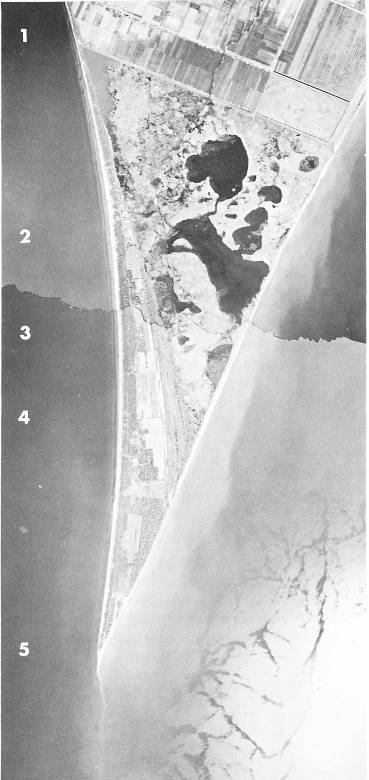
Point Pelee peninsula reveals some of the changes that have taken place at its southern tip in the recent past in this mosaic of aerial photographs.
Former shorelines are visible as sweeping lines along and inside the western (left) shore; they are especially well marked opposite 3 and 4. They are clearly cut off by the present eastern shore, suggesting that the major trend in recent times has been erosion along the eastern shore and addition of land along the western shore.
The dark rounded areas are ponds and the irregular grey parts around them are the marshes. The neat pattern of fields outside the park opposite 1 is maintained by a series of dykes.
On the day these photographs were taken the waves and shore currents were stirring up the bottom sediments along the eastern or right shore and carrying them along toward the southern tip, which extends out under the water opposite 5 as an indistinct grey line.
The irregular line of change in color across the water between 2 and 3 is where two different photographs come together.
The reason for the erosion by modern waves and currents is a matter of concern to park authorities, scientists, and shipping people alike, for it obviously represents a change of some kind. Some have suggested that commercial dredging for gravel and sand or the establishment of a channel for ships to the south and southwest of Pelee Point have caused changes in the bottom contours which would result in erosion of the point. Slight changes in climatic conditions would mean slightly different winds and therefore different wave and current patterns. It seems very likely that Pelee Point was formed at a time when the level of Lake Erie was slightly higher than it is now, and that a different set of conditions due to the lowering of the lake level has resulted in a general readjustment. Whatever it is, the cause of the erosion there now must lie in changes in waves and currents.
The role of vegetation in slowing down erosion is an important one indeed. The cover of grasses, shrubs and trees keeps the sand from being blown about by wind and partly protects it from being washed away by storm waves and currents.
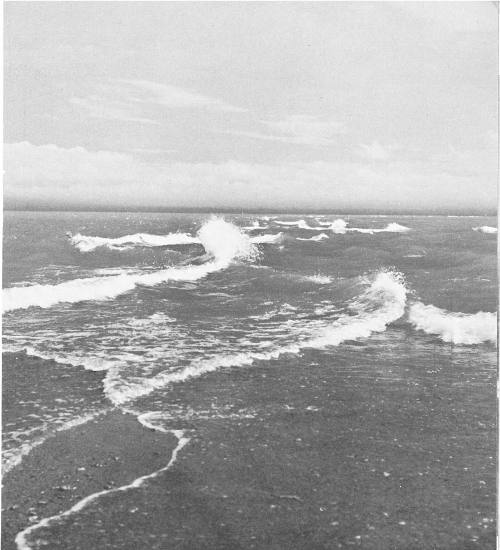
The view from the tip of Pelee Point to the south shows waves and currents from two directions meeting in choppy waters that trace the underwater extension of the spit for several miles. The two sets of waves are clearly visible in the pattern in the foreground; the plumes are where they cross each other.
The fresh-water marshes in the interior of Point Pelee peninsula have been formed by the enclosure of several areas between spits of sand working down each side of the point. Wild life of many kinds thrives in these marshes and ponds which are protected from the violence of the open lakes and, in some respects, from the violence of man. Heavy growth of vegetation over the years has added a thick blanket of dark organic matter to the bottoms of these ponds.
Beaches are fascinating places for they represent the meeting place of the water and the land. They are the birth place of many of nature’s creatures and often their final resting place. Beaches are places of constant change with the motion of the waves and the waters shifting sand grains to and fro, rolling pebbles back and forth, snatching something from the beach, or casting something up onto it.
The sand and gravel that make the beaches of Point Pelee National Park are derived from the country all around. Glacial deposits, sand from the bottom of Lake Erie, and fragments from exposures of rock along the shore of the lake have all contributed to the formation of the peninsula, making it a great mixture of bits and pieces of rocks and minerals from a variety of sources. As on most beaches, quartz is the most abundant mineral because it resists wear and chemical breakdown more than any other common mineral. Black grains of magnetite (iron oxide) are to be found everywhere along the beach, and in some places they may be segregated into dark streaks by the wave motion. Fragments of a variety of igneous rocks—some grey, some black, some pink—are all there, brought long ago from hundreds of miles to the north by the moving glaciers, and redistributed by waves along the shores.
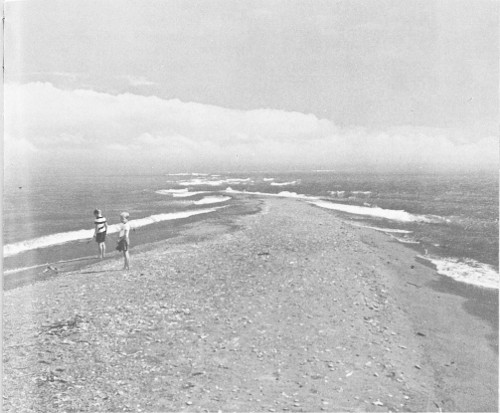
The end of Pelee Point is the southernmost point of mainland Canada. In this somewhat stormy view, waves are breaking on both sides on sandy slopes that lead back to a mixture of pebbles and sand along the top of the spit. Many of these pebbles contain fragments of fossils.
Perhaps the most interesting fragments of all are the greyish limestone pebbles, for many of them contain well-preserved fossils—remains of ancient living things. Half a dozen different kinds of fossils may be picked up in a few minutes. The best place to look is along the waveline for when the pebbles are wet their internal constitution is much more easily seen. Honeycomb corals, crinoid stems, and fragments of brachiopod shells are the most common. Unlike the far-travelled igneous rocks, these limestone fragments are from bedrock not very far away. The fossils in them show this.
Point Pelee National Park is at the south end of a complex sand spit formed when the level of Lake Erie was a little higher than it is now. Changes in waves and currents have caused conditions to change in recent times so that the peninsula is being very actively eroded in many places. The marshes and lakes in the interior have been cut off from the open lake by bars built by the waves. The beaches provide not only a cool place in summer but a place where many of nature’s very interesting processes and creatures can be seen.
A Guide to Geology for Visitors in Canada’s National Parks, by D. M. Baird (1963). Published by the National Parks Branch, Department of Northern Affairs and National Resources. Available from the Queen’s Printer, Ottawa, or from any of the National Parks. This is an illustrated pocket book of about 160 pages, written in layman’s language, which sets forth the general principles of geology and the origin of scenery, with special references to the National Parks of Canada.
Geology and Economic Minerals of Canada. Economic Geology Report No. 1 (1957) of the Geological Survey of Canada. Available from the Queen’s Printer, Ottawa, or from the Geological Survey of Canada, Ottawa. This is a wonderful source book of information on the geology and mineral deposits of Canada.
Maps and Technical Information:
Geological Map of Southwestern Ontario, by J. F. Caley and B. V. Sanford (1958). Map 1062A of the Geological Survey of Canada. Available from the Queen’s Printer, Ottawa, or from the Geological Survey of Canada, Ottawa. Relates Point Pelee, Flowerpot Island and Georgian Bay Islands to the regional geology of southwestern Ontario.
Erosion and Sedimentation at Point Pelee, by E. M. Kindle (1933). Annual Report of the Ontario Department of Mines, Vol. XLII, Part II, 29 pages. Available from the Ontario Department of Mines, Toronto. A detailed account of Point Pelee and what is going on there. A little out of date but still informative and interesting.
Brockville-Mallorytown Map-area, Ontario, by J. F. Wright (1923). Memoir 134 of the Geological Survey of Canada. Available from the Queen’s Printer, Ottawa, or the Geological Survey of Canada, Ottawa. A detailed account of the geology of an area that includes several of the islands in St. Lawrence Islands National Park. It gives a good idea of the regional setting, what rock formations are to be found, and something of the history of the scenery.
Particular questions of a geological nature concerning the National Parks in Ontario should be addressed to the Director, Geological Survey of Canada, Ottawa.
For information on all other matters concerning the Ontario National Parks write to the Director, National Parks Branch, Department of Northern Affairs and National Resources, Ottawa.
[The end of The National Parks in Ontario: A story of islands and shorelines by David M. Baird]